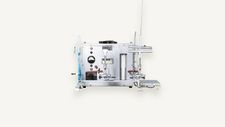
Trouble in the Air
In April 1963, the newspaper Bild headlined an article with a joke that long ago stopped being funny for many in North Rhine-Westphalia: “3 Sneezes = One Briquette”.
Power plants, factories and traffic emit dust and poisonous exhaust by the tonne. Particularly problematic is sulphur dioxide, which is produced by burning coal and oil. The colourless gas has an acrid smell and is highly corrosive. Sulphur dioxide can cause bronchitis and cardiovascular illness in humans, and severe damage to plants and buildings.
In 1954, chemist Heinrich Stratmann developed a process for determining the precise level of sulphur dioxide in the air. The so-called “Stratmann case” named after him might seem bulky and a bit old-fashioned, but was state-of-the-art in the 1950s. The device fits easily into a car or on a handcart and can thus be deployed anywhere in the state. With the help of his portable box, Stratmann did pioneering work in the field of air pollution monitoring.
In the meantime, the state parliament passed an air pollution control law in 1962. Thresholds for pollutants and the installation of filtering systems notably improved air quality. Then, in the 1980s, the big lignite-fired power plants in the Rhineland were fitted with cleaning systems for their fumes. The state could finally breathe more freely.